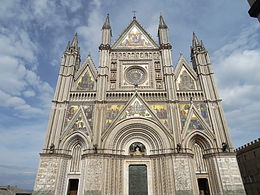Cathedral of Orvieto
| Orvieto Cathedral (Duomo di Orvieto) |
|
|---|---|

Façade of the cathedral
|
|
| Basic information | |
| Location | Orvieto, Italy |
| Affiliation | Roman Catholic |
| Province | Terni |
| Country | Italy |
| Ecclesiastical or organizational status | National monument |
| Status | Active |
| Website | http://www.opsm.it/ |
| Architectural description | |
| Architectural type | Church |
| Architectural style | Romanesque |
| Groundbreaking | 1290 |
| Completed | 1591 |
Orvieto Cathedral (Italian: Duomo di Orvieto; Cattedrale di Santa Maria Assunta) is a large 14th-century Roman Catholic cathedral dedicated to the Assumption of the Virgin Mary and situated in the town of Orvieto in Umbria, central Italy. Formerly the episcopal seat of the Diocese of Todi, it has been since 1986 that of the Diocese of Orvieto-Todi.
The building was constructed under the orders of Pope Urban IV to commemorate and provide a suitable home for the Corporal of Bolsena, a miracle which is said to have occurred in 1263 in the nearby town of Bolsena, when a travelling priest who had doubts about the truth of transubstantiation found that his Host was bleeding so much that it stained the altar cloth. The cloth is now stored in the Chapel of the Corporal inside the cathedral.
Situated in a position dominating the town of Orvieto which sits perched on a volcanic plug, the cathedral’s façade is a classic piece of religious construction, containing elements of design from the 14th to the 20th century, with a large rose window, golden mosaics and three huge bronze doors, while inside resides two frescoed chapels decorated by some of the best Italian painters of the period with images of Judgment Day. The cathedral has five bells, dating back to Renaissance, tuned in E flat.
The construction of the cathedral lasted almost three centuries with the design and style evolving from Romanesque to Gothic as construction progressed. The flagstone of the cathedral was laid on 13 November 1290 by Pope Nicholas IV, and construction was entrusted to chief-mason (capomastro) Fra Bevignate di Perugia (also called Fra Bevignate da Gubbio) using a design by Arnolfo di Cambio (the architect of the cathedral of Florence). The cathedral was initially designed as a Romanesque basilica with a nave and two side aisles. But when Giovanni di Uguccione succeeded Fra Bevignate, the design was transformed into Italian Gothic forms.
...
Wikipedia
